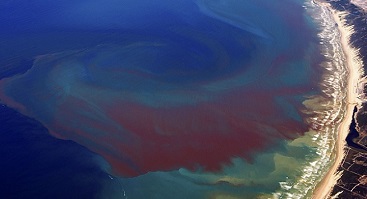 TAMPA, FLA.—The ongoing red tide and blue-green algae outbreaks affecting Southwest Florida has prompted Governor Rick Scott to issue two emergency orders to aid those areas negatively affected—one order involving those seven counties most impacted by red tide algae and another involving those seven counties most impacted by blue-green algae. The emergency orders specify different types of initiatives—from water storage to a statewide hotline. Earlier this week, Scott also requested the U.S. Small Business Administration (SBA) to issue an Economic Injury Disaster declaration to help businesses in Martin and Lee counties—those counties hit the hardest by both types of algae. The declaration would give low-interest loans to small businesses, so they can recover from the harm caused by the algae blooms. Once approved by the SBA, the state will work to include other impacted areas.
TAMPA, FLA.—The ongoing red tide and blue-green algae outbreaks affecting Southwest Florida has prompted Governor Rick Scott to issue two emergency orders to aid those areas negatively affected—one order involving those seven counties most impacted by red tide algae and another involving those seven counties most impacted by blue-green algae. The emergency orders specify different types of initiatives—from water storage to a statewide hotline. Earlier this week, Scott also requested the U.S. Small Business Administration (SBA) to issue an Economic Injury Disaster declaration to help businesses in Martin and Lee counties—those counties hit the hardest by both types of algae. The declaration would give low-interest loans to small businesses, so they can recover from the harm caused by the algae blooms. Once approved by the SBA, the state will work to include other impacted areas.
Directed by Scott, VISIT FLORIDA has launched two programs to assist local tourism development boards in counties including Collier, Lee, Charlotte, Sarasota, Manatee, Hillsborough and Pinellas counties. The Tourism Recovery Grant Program for Red Tide and Red Tide Recovery Marketing Program are designed to assist each affected county with marketing their destination once red tide has subsided.
The $500,000 Tourism Recovery Grant Program will provide financial assistance to tourism development boards to execute marketing programs through advertising, direct mail, brochure production, website development, as well as other related projects/programs. Grant applicants must submit a marketing plan outlining how they plan to spend the funds and will only receive the funds once that marketing plan has been executed. Local tourism businesses in the impacted counties will work with their local tourism development boards to be included in the marketing efforts.
The Red Tide Recovery Marketing Program is available to businesses of all sizes in the tourism industry in the counties affected by red tide. This program provides six months complimentary VISIT FLORIDA marketing partnership, which includes an enhanced web listing on VISITFLORIDA.com, the ability to submit content for exposure on VISIT FLORIDA’s social media channels, media blog and website, the ability to promote Partner-to-Partner specials and more. This program also provides the opportunity to have a presence in the official Florida Welcome Centers with brochure distribution, lobby booth displays and showcase participation.
Ken Lawson, President & CEO of VISIT FLORIDA, said, “Florida’s economy is fueled by travel and tourism and it’s VISIT FLORIDA’s job to protect our industry. These programs will allow our destinations to show visitors that Florida is ready to welcome visitors back to its world-renowned beaches in Southwest Florida.”
Marketing Campaign Will Be Prepared
Governor Scott also tasked VISIT FLORIDA with developing a marketing campaign to assist Southwest Florida communities that will start following this year’s red tide blooms. This integrated campaign will include marketing efforts across several platforms, including advertising, promotions, social media, content production, welcome centers, and VISITFLORIDA.com. Through these channels, VISIT FLORIDA will be sharing with the rest of the state, country and the world that Southwest Florida’s beaches are back to their pristine conditions and ready to welcome visitors.
The Florida Restaurant and Lodging Association (FRLA) wants to ensure its members have access to all the information and resources necessary to help them navigate this emergency effectively. They encourage all members who are affected by the red tide to complete the Florida Department of Emergency Management’s Damage Assessment survey. There, members should select “red tide” as the event. Information gathered will help the government develop the best strategy to help businesses recover during and after this event.
According to FRLA, the Florida Department of Economic Opportunity is providing bridge loans and increasing their presence in South Florida. These interest-free loans, from $1,000 to $50,000, are available to small business owners with two to 100 employees who have suffered physical or economic damage as a result of the red tide.
Wildlife Impacted Greatly
Florida sees red tide—an algae outbreak that can kill marine life and sicken humans—nearly every year, but the current flare-up has become severe enough to warrant the state of emergency. The current outbreak has already lasted 10 months, killing thousands of pounds of fish, as well as wildlife including dolphins, sea turtles and a whale shark. According to an NPR report, hotel occupancy in some counties has dipped 5 to 10 percent.
“We are seeing the degree of impact vary,” says Amanda Handley, Press Secretary for FRLA.
Red tide is caused by an influx of microscopic algae called Karenia brevis, which give water a namesake reddish hue. The organisms, typically found in the Gulf of Mexico, produce toxins that interfere with nerve transmission. Humans can develop gastrointestinal illness after eating shellfish contaminated with high levels of Karenia brevis and suffer from respiratory irritation from breathing in toxins produced by the algae, which also result in an acrid odor.
Red tide and an explosion of other algae in the canals and waterways through Southwest Florida can be blamed on an influx of nutrients flowing from as far away as Lake Okeechobee and even by air from Africa, according to experts.
Lake Okeechobee Discharges Have Huge Impact
Cris Costello, Organizing Manager, Florida Chapter, Sierra Club, says Florida has a lot of land-based nutrient pollution that is feeding the algae. It comes from manure, undertreated sewage, fertilizer and malfunctioning septic systems. Many of the nutrients come from Lake Okeechobee discharges.
“The more people we have, the more nutrient pollution we have,” she says. “The more impervious surfaces we have, the greater the runoff. It runs right off the land and goes into receiving water bodies—streams, creeks, ponds, the coast. That runoff has been happening for a long time. We need to stop pollution at its source. We have not stopped it.”
Conditions including 90-degree water temperatures and optimal nitrogen and phosphorous levels make conditions right for algae populations to explode. “We are in the perfect storm,” Costello says. “We had a bad problem in 2008. It has gotten worse. The flow of pollutants has gotten worse.”
Glenn Hasek can be reached at editor@greenlodgingnews.com.






